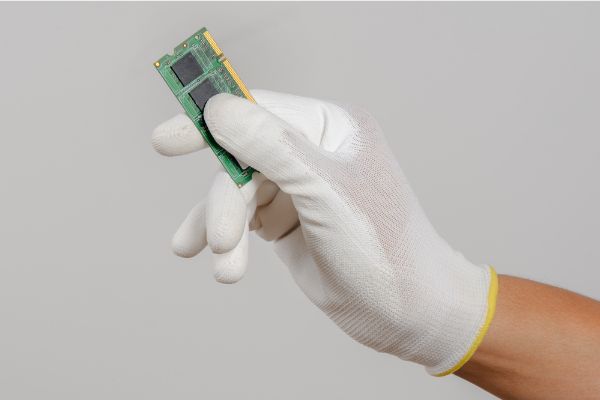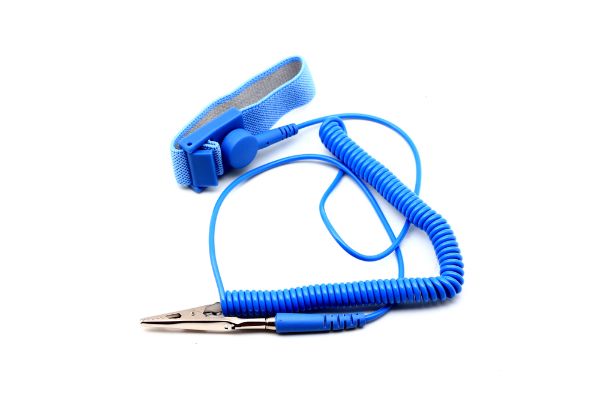Disclaimer: This post may contain affiliate links, meaning we get a small commission if you make a purchase through our links, at no cost to you. For more information, please visit our Disclaimer Page.
For many tech hobbyists, building a first personal computer can be a huge milestone moment. It is easy enough to purchase a stock rig right off the shelf, but creating your own computer allows you to customize it to your preferences.
Indeed, it could even end up being less expensive for you to get a system with parts that are on the higher end of the spectrum than similar ones you’ll find in pre-built rigs. You may spend more time researching how to put a PC together, what parts are essential, how to hook them up, and how to test the system once you complete it, but you could end up with one that you know literally inside and out.
Part of the research that you might overlook is what to wear when you are putting things together or hooking them up to power sources. While this may seem trivial, what you wear for a PC building session might mean the difference between possible injury to yourself or unintentional damage to some of the parts of your system.
The last thing you want is to short out or break that new component for which you spent days searching, and the right clothing can help with that. We will go over whether you wear protection on your hands, check if it’s okay to wear shoes, and talk about possible static electricity issues. Furthermore, we’ll give you some tips on stopping static buildup, and we’ll provide some catchall troubleshooting for a few other things that you should keep in mind during this process.
Table of Contents
Should I Wear Gloves While Building a PC?
Before we get into whether you should wear gloves during a build, it is important to go over some of the properties that gloves from different materials may have. You are probably familiar with some of the usual components that go into gloves.
Some of the most ubiquitous glove types include cloth, leather, rubber, or latex. There are pluses and minuses to each material, but that doesn’t mean that there are no clear favorites when it comes to wearing them specifically when you want to build a computer. Some people in the tech community may recommend antistatic gloves of some kind for extra protection against buildup that could harm your computer’s more sensitive components.
While there is nothing wrong with taking the extra precaution here, it may not make a huge difference when it comes to putting your PC together. The additions you get from the gloves may be minimal, and they may not outweigh potential problems you might invite just by wearing them. Most kinds of antistatic gloves should be relatively thin in their construction.
However, you may not have as much fine feeling in your fingers even with just this thin layer covering your hands. Because of this, the gloves can make it harder to put things together in your computer successfully. This is particularly true in the case of the motherboard, a part that needs you to feel around for tight spots in order to set it properly.
As a compromise, you could wear an antistatic wrist strap on your person while you are working with your computer parts. This strap can help to make sure that you ground yourself, and it can mitigate the problems that come from static electricity.
Once you wrap the appropriate end of the strap around your wrist, you’ll clip the other end of it to a large metal object somewhere nearby. Doing this can keep the static that would otherwise buildup away from you and your PC.
Can I Wear Socks and Shoes When Building a PC?
Yes, it should be fine to wear socks and shoes while you build. If you would like to take extra precautions, you can wear sandals instead of just socks.
This kind of outfit would help you make sure that there is no unexpected buildup of static. However, it is not strictly necessary for a person to choose one type of footwear over another when they are considering what to wear during a building session. The advice we gave regarding the antistatic wrist strap should be sufficient to alleviate most potential concerns any hobbyist might have over this kind of thing.
Furthermore, if you are concerned about static transfer from the carpet to your feet, you can set up your build area in a place that has hardwood or other types of flooring. Doing this can help you make sure that the chances of catching any static are minimal. With that said, some type of foot protection might be a good choice, too. There is always a chance that you might drop and step on a small part. If you have something on your feet already, you can reduce the chances of minor injuries from incidents like this as you build.
Should I Worry About Static When Building a PC?
Although we’ve covered it in some aspects already, it is worth remembering that there is some risk to your computer’s parts during a build. Part of this risk comes from unexpected electricity building up in you and discharging into the computer components with which you are working.
Even though static electricity is something that might seem light to you, a strong enough discharge can harm the semiconductors and other tiny, sensitive components in different PC parts, and this is thanks to the voltage going into them being too high. When this happens, those tiny parts can burn themselves out.
Today, many manufacturers that produce computer parts will make them in such a way that they rate them to handle a minimum amount of static discharge. You can think of this rating as a safety measure that companies design and implement in order to insulate the components, and part of the reason they do it is in case users introduce such a charge to the system.
Tinkering with the PC or upgrading it are not the only ways that you might push a charge through the machine without meaning to, but making modifications is one of the typical ways it can happen. For the most part, computer hardware that might be in danger from static electricity has a voltage rating as a type of ceiling.
If you go above this rating, it is possible that the charge you generate can blow out the chips. Because it can be difficult to detect how much of a charge your static buildup has within itself, it is a good idea to take some of the precautions we’ve mentioned here.
How Do You Stop Static Electricity When Building a Computer?
Preventing static electricity from causing damage to your computer is one of the most important jobs you have when it comes time to mess around inside it. If you fail, you could find that the rogue electricity damaged your PC, but that might not be the worst of it.
The other problem with static electricity is that you won’t see any obvious signs that it did anything. Your computer may simply fail to start when you insert everything, close it up, and turn it on in order to test it. Additionally, you may find that your computer works fine for a while, too.
Even so, it may start to get sluggish over time, or it may fail one day without any warning or explanation. When these things happen, the culprit could be static electricity that you let loose during a build, but you won’t have any way of knowing if that is so.
We’ve touched on some of the things you can do to avoid this kind of issue already. Because it is such an important accessory, we will remind readers not to forget their antistatic wrist straps.
There are a few other precautions that you might take, and you can start with leaving the power supply unit connected. Although this may seem counterintuitive, it can help you avoid a static buildup.
However, you should make sure that the PSU itself is not in a powered state while you are working inside the chassis of the PC.
Keeping it turned off like this can help you with the buildup, and it also mitigates the possibility of a more serious electric shock harming you or your computer.
Although we mentioned touching a metal surface from time to time, this is probably something you should do each time you’re about to handle or install a new component. If you keep up a rhythm like this, you can lower the chances of a discharge frying anything delicate in the component you’re going to set up.
Your wrist strap should be sufficient protection for your computer, but you can also invest in a special mat to stand on that can help you discharge that buildup while you are working.
What Are Some Other Safety Measures When Building a PC?
For the most part, we’ve talked about just static discharge, its possible effects on your computer, and how to avoid building it up in your system.
However, there are a few other precautions you can take during the process of putting your PC together, too. Although the specifics might vary, here are some general guidelines you can follow:
1. Many of the parts you’ll put inside your computer have contacts. These parts might include the graphics card, RAM, or processing unit.
It is best if you don’t touch these contacts during the build. Your bare hands have mixtures of different things on them at all times, and these chemicals could make the contacts dirty. It may seem small, but dirty contacts can cause your system to run incorrectly.
2. You want a secure fit for your parts, but you should not tighten your screws too much. Too much torque can put constant strain on the parts inside the computer, leading to pin or pad contact that could impact things negatively.
3. Make sure that you give yourself enough room to work comfortably.
4. You should consider using a magnetic tray to keep tiny metallic parts from falling where you can’t find them.
5. Most memory kits have ratings for running at specific frequencies. Therefore, when you perform an upgrade or build, do not mix different memory kits.
Conclusion
As you can see, there might be some special accessories you will want to have with you or on your person when you’re putting a computer together. However, your fashion options when it comes to a PC build tend to remain just as versatile as they are when you’re performing a host of other tasks.
Just remember to take precautions against any static discharge, and be mindful of some of the other guidelines you should follow.
References:
What glove can I wear when building my PC? from pcmasterrace
https://pcbuildsonabudget.com/do-you-need-to-wear-gloves-while-building-your-pc
https://linustechtips.com/topic/1137756-socks-while-building-pc/
https://www.quora.com/Why-is-static-electricity-bad-when-building-a-PC


